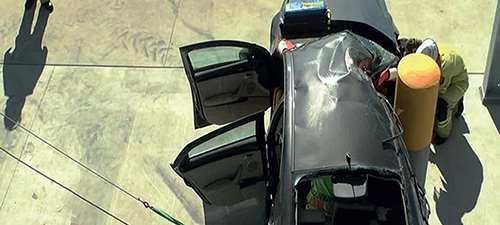Vehicle Relocation - Can We, Really?
I received a call on the way into work this morning. The call was from Dr Mark Forrest. As well as being an anaesthetist, he is Medical Director of Cheshire Fire and Rescue Service in the UK (my old service). He is also a very good friend of over 10 years.
His role means he oversees clinical governance (ultimate responsibility for all medical care given by the firefighters) and also operational response. He goes to incidents.
He called to tell me about an incident he attended in the last 24 hours. It was a car versus truck incident at relatively high speed, with front/side intrusion into the passenger side. The extrication was complex for several reasons but it was successful. Without going into too much detail, there was a point where vehicle relocation was considered in order to improve access.
Fine balance
This is an interesting concept and may be new to some readers. The idea of relocating the vehicle (or moving it to another position prior to extrication) seems to contradict everything we know and understand about the principles of vehicle stabilization, but we should remember that our extrication plan is a fine balance between:
- Safety
- Available time (based on medical information)
- The casualty’s location, orientation and dynamic medical condition
Incident commanders must decide whether relocation of the vehicle is a priority. This decision must be made early as vehicle relocation can be time consuming, leading to an extended time on scene. It may also require additional resources such as winches or specialist lifting equipment.
Why consider relocation?
But exactly WHY would we consider relocating the vehicle? Well I am sure you have been to extrications where access is restricted or the position of the vehicles compromises the safety of the team.

Right hand drive vehicle being relocated (winched) to improve driver access. (Picture courtesy of ARRO)
Ask yourself the question
Incident commanders should ask themselves the following question: Will relocating the vehicle make the extrication safer and/or quicker without compromising the crew or the patient?
If the answer to this question is YES then it should be a very real consideration. Of course your decision MUST be based on how long the relocation will actually take; do you have the correct resources on scene and if not, how long will they take to arrive? If the sum total of the time it takes to move the vehicle and then extricate is considered to be prolonged, then maybe leaving it in situ and devising a plan is the best option. Remember, however, that it is never just about time to extricate and that all other factors must be considered, to ensure that you work safely and in the best interest of the patient. Consider the impact relocation will have on the casualty and seek the advice of the on-scene medic.
For your consideration
Vehicle relocation is a step outside the box, but I implore you to consider the advantages and weigh up your options.
As for the incident Dr. Forrest told me about; it sounds like there will be a positive outcome and he had nothing but praise for the rescuers involved in a difficult extrication. It is great to hear of operational crews thinking laterally and embracing ideas and concepts that perhaps they previously wouldn’t have.
I would urge you to follow Mark on Twitter: @Obidoc
As ever, I welcome your feedback!
Ian Dunbar